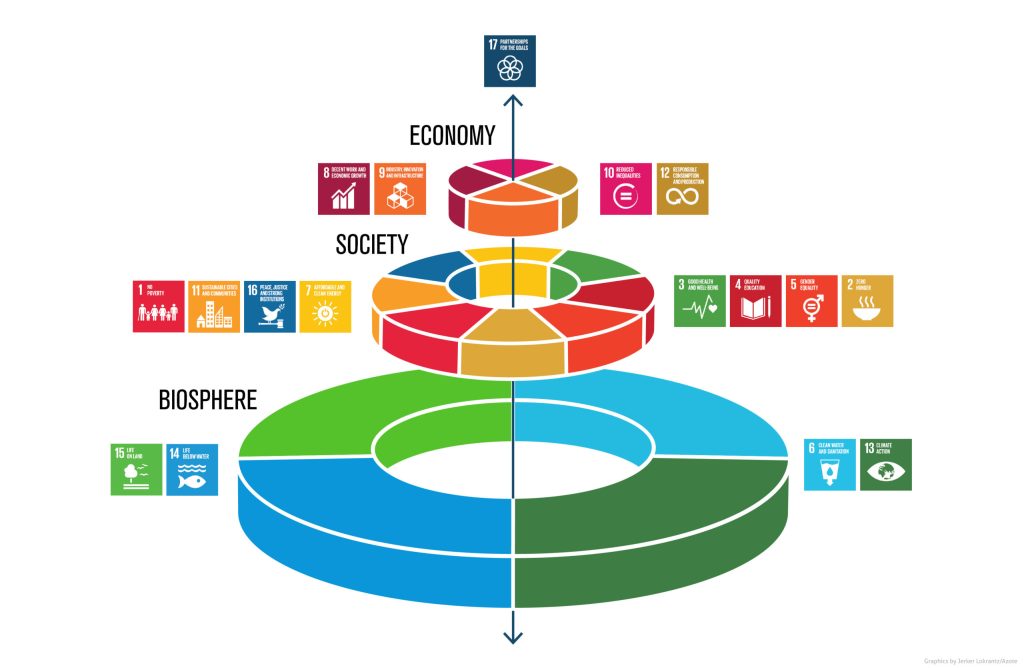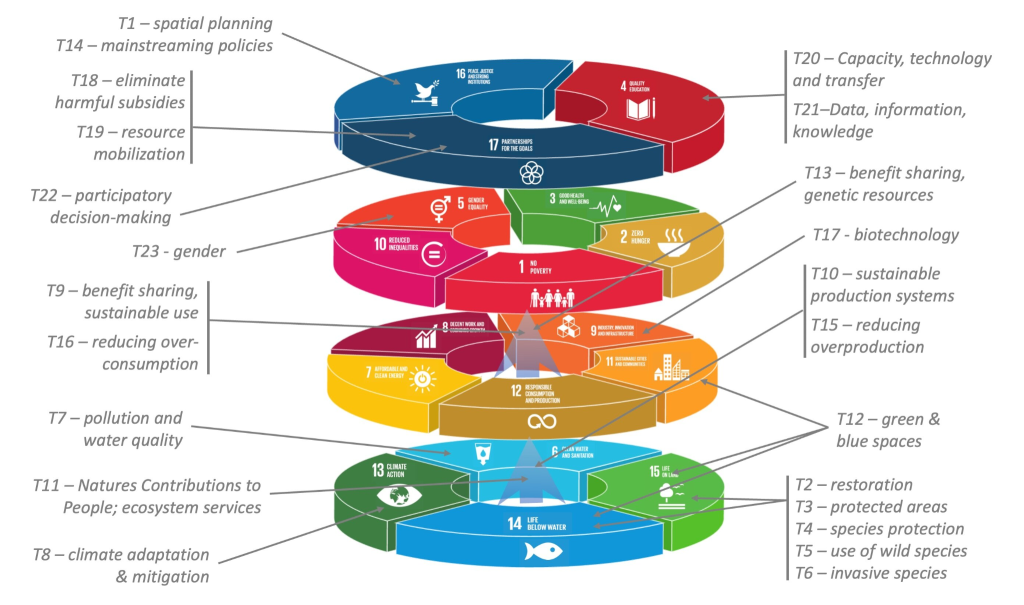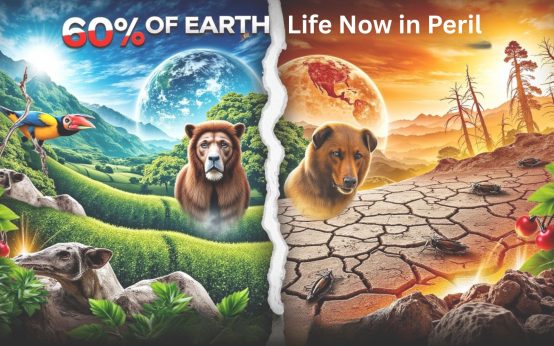Nature is being damaged faster than ever, Ecosystems and this is hurting the benefits it provides to people. Healthy ecosystems and the plants and animals they support give us food, clean air, and water. But human activities destroy 10 million hectares of forests every year and put 40,000 species at risk of disappearing. This makes it harder for the land to support life on Earth.
Goal 15 and the Environment
Forests cover one-third of the Earth’s land, provide homes for 80% of land animals and plants, and absorb 30% of emissions from industry and fossil fuels. Cutting down trees reduces these benefits and adds more than 11% to the world’s pollution. When land becomes unusable, people fight over resources, which can lead to poverty, hunger, and forced migration.
Countries must follow through on their promises to restore 1 billion hectares of damaged land. This is needed to keep global warming below 2°C, provide food for the growing population, and slow the loss of species. Planting trees alongside crops (agroforestry) could help feed 1.3 billion people. Governments must also protect more land and create stronger rules to stop illegal logging, poaching, and other harmful activities in national parks.
Putting a money value on nature’s benefits can help protect it. Governments can do this by making laws on taxes, trade, and business rules, while companies and banks can focus on eco-friendly investments. The world needs to invest three times more in nature-based solutions by 2030 and four times more by 2050 to tackle climate change, save biodiversity, and stop land from becoming unusable.

Why 30% Ecosystems?
Scientists tell us that protecting 30% of our land and oceans is a critical point. It’s like a safety net for nature. It gives animals and plants space to live, grow, and recover. It helps keep our planet healthy.
Why 2030? Because time is running out. We’re losing species at an alarming rate. Climate change is making things worse. We need to act quickly and decisively.
The Three Enemies: Biodiversity Loss, Ecosystem Collapse, and Desertification
Biodiversity Loss: This means animals and plants are disappearing. Think of it like a library losing books every day.
We’re losing the variety of life that makes our planet amazing and keeps it working.
Bees that pollinate our food, fish that keep our oceans balanced, and forests that clean our air are all in danger.
Ecosystem Collapse: An ecosystem is a community of living things and their environment. Coral reefs, rainforests, and wetlands are examples.
When ecosystems collapse, it’s like a house falling apart. The whole system stops working. We lose the services they provide, like clean water and air.
Desertification: This is when fertile land turns into desert. It’s caused by things like cutting down trees, over-farming, and climate change.
It means less food, less water, and more problems for people and animals.
The Rescue Plan: How Do We Save Our Planet?
This rescue mission is big, but we can do it. Here’s how:
1. Protect What’s Left: Create Safe Havens for Nature

-We need to create more protected areas, like national parks and marine reserves. These are places where nature can thrive.
-Expand existing protected areas: Make them bigger and better connected.
-Create new protected areas: Focus on areas with high biodiversity and important ecosystems.
-Work with local communities: They know the land best and are key to protecting it.
-Protect Oceans: Oceans are vital to our planet. We need to protect marine areas from overfishing, pollution, and damage.
-Why is this important? Protected areas give nature a chance to recover. They help keep animals and plants safe.
2. Restore What’s Broken: Heal Damaged Ecosystems
We need to fix the damage we’ve done.
Reforestation: Plant trees to restore forests and help fight climate change.
Wetland restoration: Bring back wetlands that have been drained or damaged.
Coral reef restoration: Help coral reefs recover from bleaching and other threats.
Restore grasslands: Help restore areas that have been overgrazed.
Why is this important? Restoring ecosystems helps bring back biodiversity and makes our planet healthier.
3. Change How We Live: Make Sustainable Choices
We need to change our habits and make choices that are good for the planet.
Eat sustainably: Choose food that is grown or caught in a way that doesn’t harm the environment.
Reduce waste: Use less plastic, recycle, and compost.
Conserve water: Use water wisely and avoid wasting it.
Use renewable energy: Switch to solar, wind, and other clean energy sources.
Support sustainable businesses: Buy products from companies that are committed to protecting the environment.
Why is this important? Our daily choices have a big impact on the planet. We need to make sustainable choices to reduce our footprint.
4. Fight Climate Change: Reduce Greenhouse Gase
Climate change is making everything worse. We need to reduce greenhouse gas emissions.
Transition to renewable energy: Move away from fossil fuels and use clean energy.
Improve energy efficiency: Use less energy in our homes, buildings, and transportation.
Protect forests: Forests absorb carbon dioxide, so we need to protect them.
Support climate action: Advocate for policies that reduce greenhouse gas emissions.
Why is this important? Climate change is a major threat to biodiversity and ecosystems. We need to act now to reduce its impact.
5. Educate and Inspire: Share the Message

We need to teach people about the importance of biodiversity and ecosystems.
Schools and communities: Educate people about the problems and solutions.
Media and social media: Spread awareness and inspire action.
Share success stories: Show people that conservation efforts can work.
Get involved: Volunteer with conservation organizations.
Why is this important? When people understand the problem, they are more likely to take action. Education is key to creating a sustainable future.
We Can Make a Difference
The 2030 rescue mission is a challenge, but it’s not impossible. We all have a role to play.
Start small: Make small changes in your daily life Ecosystems.
Get involved: Volunteer with a local conservation group.
Support organizations: Donate to organizations that are working to protect biodiversity and ecosystems.
Advocate for change: Contact your elected officials and ask them to support environmental policies.
Spread the word: Talk to your friends and family about the importance of conservation.
We are the guardians of this planet. We have a responsibility to protect it for future generations. Let’s work together to make the 2030 rescue mission a success. Let’s save Earth’s wild heart.



 60% of Earth’s Life Now in Peril : Reversing Unprecedented Biodiversity Collapse Through Global Action
60% of Earth’s Life Now in Peril : Reversing Unprecedented Biodiversity Collapse Through Global Action
GOOD!
WONDERUL!
SUPER!